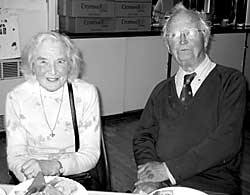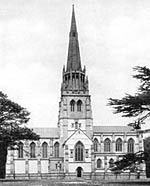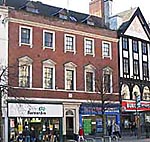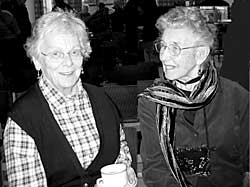News for Summer 2007
 |
Left to right: Barbara Cast, Keith Goodman, John Beckett, Rosalys Coope |
The Annual General Meeting 2007 at Arnold
Over eighty members assembled for the Society’s AGM on Saturday 28 April, on what was a beautiful spring day. The attractive garden setting of the venue lent itself to this sunny day, maybe surprisingly as it was held in a more urban location than our usual AGMs. This year we were in Arnold, however, in St Mary’s Church Centre, at the “top of town”, and we could have been in the heart of the countryside.
The AGM took its usual course; the President, Dr Rosalys Coope, welcomed members and Professor John Beckett, our Chairman, ably presided in his own inimitable style. Members thanked Keith Goodman, who has stepped down from his role as Treasurer, and the President, on behalf of the Society, presented him with an inscribed fountain pen.
John Wilson takes over from Keith as Treasurer, with John Hamilton taking on the role of Membership Secretary. New to Council this year is Peter Smith, known to many members from visits to notable Nottingham sites. He takes the place of Bob Creates who has left Council to concentrate on his many other activities – thanks to him for his contribution but, don’t worry, he will still be active at lectures struggling with the technology, along with Peter Reddish – but more on that in a later edition. We also officially elected Keith Challis as Archaeology Editor – just as well, as he had been doing the job for a year already!
 |
Mr and Mrs Sears. |
If you have never been to an AGM you might think it would be a dry event, discussing finances and elections and such things. But you would be wrong – although part of it, the shortest bit, is the business meeting, your officers always try to make it an event which opens up yet another part of our county’s history on which to gaze.
This year we had a very interesting talk on the history of Arnold by Eric
Dove, an Arnold local historian, and we visited the adjacent church of
St Mary, led by Alan Langton who has a long association with the church.
He explained the key points of the building, including the Easter Sepulchre,
founder’s tomb and double piscina, and told us something of its history,
including its current position on a raft installed by the Coal Board back
in the 1950s when they were keen to mine the rich seams beneath. Whilst
in the church we were serenaded by the Chairman on the organ – yet
another enjoyable element of what was a very pleasant, companionable day.
Many thanks to Alan Langton for his tremendous contribution to the arrangements,
and to the ladies of the St Mary’s Fellowship for another splendid
AGM tea.
Barbara Cast, Hon Secretary
John Wilson, Treasurer
 |
John was born and raised in Nottingham, attending Mundella Grammar School and the University of Nottingham, where he met his wife Anne. John is a pharmacist by profession, being one of the last of the Apothecary’s Apprentices under the old regulations before pharmacy became an entirely graduate profession. He underwent his apprenticeship to a pharmacist at Boots’ Branch 11, which stood on the corner of Shakespeare Street and Mansfield Road (now the Sony Centre). He well remembers making up prescriptions by weighing out the individual ingredients!
He has been retired for a number of years, following a long career in hospital pharmacy, lecturing and NHS administration, but he still carries out occasional locums at a community pharmacy for a friend. He has always been interested in history, thanks to an inspiring teacher, Mr Davies, now long departed. Since retirement, John has had more time to devote to history (in spite of having four grandchildren living locally!) and he particularly enjoys his contact with the Thoroton Society. His other interests include meteorology and genealogy.
John Hamilton, Membership Secretary
 |
John Hamilton was born in 1938 of Nottingham parents. His grandparents were early members of the Thoroton Society. He grew up in Buckinghamshire, and was educated at Sedbergh School and Oriel College, Oxford, reading Classics and History. He later obtained an Advanced Certificate in Archaeology at the University of Nottingham. John worked for Boots in buying and marketing in London and Nottingham, and is now retired. He has lived in Burton Joyce for over thirty years. He attended the Archdeaconry Research Group run by David Marcombe for many years, and co-edited the book on Nottinghamshire's Religious Houses with him. John now spends his time researching and writing up his family history. He is married to Vibeke from the Danish island of Bornholm, and they have two daughters and four grandchildren.
THOROTON SOCIETY LUNCHEON, 3 NOVEMBER 2007
This year, in honour of the 150th anniversary of the birth of Thomas Hawkesley, the greatest authority of his day on the supply of public water, we are holding our annual luncheon in Bestwood Pumping Station, now known as Lakeside. You will receive booking forms with the August Newsletter.
KEITH CHALLIS – ARCHAEOLOGY EDITOR
Keith has twenty years experience as a professional archaeologist. After working for nearly 13 years at Nottingham University with Trent & Peak Archaeology and for two years with the York Archaeological Trust, Keith is presently GIS and Remote Sensing Manager with the HP Vista Centre and a Research Fellow in the Institute of Archaeology and Antiquity at Birmingham University. His role involves the design, development and management of research projects and consultancy focused on landscape archaeology, GIS and remote sensing and acting as course director for Birmingham’s MA in landscape archaeology and geomatics. As well as taking on the role of archaeological editor of Transactions of the Thoroton Society, Keith recently guest edited a special issue of Archaeological Prospection devoted to remote sensing in alluvial environments. He has worked widely in British and Middle Eastern landscape archaeology, and his particular research interests are in the application of GIS to cultural resource management and strategic decision-making, particularly in alluvial environments and the application of airborne and satellite remote sensing in field archaeology.
Bodley and Kemp
 |
It is the centenary of the deaths of both George F Bodley (1827-1907) and Charles E Kempe (1837-1907). Bodley was one of the most important architects of the Gothic Revival and an early patron of William Morris, although he himself designed outstanding wallpapers. Kempe was one of the most influential church decorators of the nineteenth century, justly famous for his stained glass windows. Bodley and Kempe were friends as well as colleagues all their working lives.
To celebrate this centenary, the Churches Conservation Trust is organising several events around the country. The “Kempe and Bodley in Nottinghamshire Tour” takes place on 22 September, led by Adrian Barlow, tutor, lecturer and author on both men. Tickets cost £25 from CCT. For enquiries, tel 020-7213-0680 or email events@tcct.org.uk – you can check ticket availability at: www.visitchurches.org.uk. The tour begins at Bodley and Kempe’s most important collaboration, the chapel at Clumber Park, and progresses to view examples of Kempe glass at Clayworth St Peter and Saundby St Martin, concluding at Corringham St Lawrence in Lincolnshire.
There are many examples of Bodley and Kempe work in Nottinghamshire which you can visit and view at your leisure. Besides Clumber Chapel, Bodley impressed Nottingham with St Alban in Sneinton, the chancel of St George, Kirkewhite Street, plus the chapter house and other parts of St Mary’s and the restoration of Clifton St Mary. He also rebuilt the chantry chapel in St Swithun, East Retford, refurbished the chancel, and restored the old church at Coddington.
Over fifty churches in Nottinghamshire can lay claim to Kempe windows. The south chancel window in St Mary’s, Car Colston, is a fine example of his early work, often considered better than later work when the pressure of demand led to repetition and lack of inspiration, as at Southwell Minster. Twenty-five windows of his early period are to be found in St Mary Magdalene, Hucknall. As Pevsner wrote “If you want to study late Victorian glass at its most competent … Hucknall is one of the best places to go”.
Above all in Kempe glass, look for the rich colours, especially reds and blues, the high quality of the drawing of faces, his angels and the wonderful harmony of design. Terry Fry
Using the collections at the University of Nottingham
This article clarifies procedures for using Nottingham University’s Library. The Manuscripts & Special Collections Department (including the East Midlands Collection) is now at the King’s Meadow Campus on Lenton Lane (formerly Carlton TV Studios). The University welcomes members of the public to use the resources of Manuscripts and Special Collections, including the open-access East Midlands Collection in the Reading Room. In addition, Thoroton members are entitled to borrow from this collection. They need to be registered as external borrowers of the University Library and will be given a library card, valid for one year, stamped ‘Thoroton Society’.
To obtain a card, you will need to make an appointment to visit the Reading Room at King’s Meadow, a passport-size photograph and proof of Thoroton Society membership, eg your programme card. Core opening hours for the East Midlands Collection are weekdays 9.15am-4.45pm. Members can also use the card to access the rest of the University Library for reference use.
The public are entitled to walk-in reference access, but the library card can be used for identification to library staff if necessary, and will operate the new security gate system in Hallward Library at University Park. Enquiries about the facilities and collections should be referred to Mrs Corinne Fawcett, Special Collections Librarian, Manuscripts & Special Collections, King’s Meadow Campus, Lenton Lane, Nottingham NG7 2NR, tel 0115 951 4562; e-mail: corinne.fawcett@nottingham.ac.uk. Information on the East Midlands Collections is at: http://www.nottingham.ac.uk/mss/collections/east-mids/. Dorothy Johnston
Bromley House
 |
Members will be delighted to know that a huge, unsightly and totally inappropriate plan to redevelop the Odeon site in central Nottingham, which would have led to Bromley House’s garden being seriously overshadowed, has been withdrawn by the developer after a raft of complaints and representations, not least from members of Bromley House, the Nottingham Civic Society, and (both officially from the society and through individuals) the Thoroton Society. Although we anticipate a further scheme being brought forward, at least for now this haven of tranquillity in the centre of Nottingham will be retained. Thank you to members (including our President) who made vigorous protests – it shows this can sometimes pay dividends. John Beckett
Visit to Swansea
As members know, we have been planning an excursion to Swansea. This is now confirmed for the weekend of 24-25 May 2008, and if you signed up for it we hope you are still able to come! The visit will include a tour of the National Waterfront Museum, of which Steph Mastoris is curator. Steph will also guide us round various other important cultural locations in South Wales.
We plan to leave Nottingham at about 8am on the Saturday and to have lunch and a tour of the museum in the afternoon. There will be an overnight stay in Swansea and more to see on Sunday morning, arriving back in Nottingham between 5-6pm. If you signed up before, or if you would now like to go, can you contact Keith Goodman at email keith.goodm@gmail.com or tel 0115 9726590 as soon as possible. Please book the date for now, and we will have costings in the near future. John Beckett
Dr Philip Boobbyer (born 1 June 1857, died 21 January 1930)
This year sees the 150th anniversary of the birth of Dr Philip Boobbyer, Medical Officer of Health in Nottingham from 1889-1929. He studied at King’s College and King’s College Hospital (London), and after qualifying as MRCS and LSA, became resident Medical Officer at the hospital and spent twelve months as a demonstrator of anatomy, subsequently obtaining degrees in both medicine and surgery. In 1884 whilst working for his degrees he secured the post of Medical Officer to the Basford Rural Sanitary District.
This gave him a good grounding for his work with Nottingham Health Department which began in 1889 as Medical Officer. His main contribution to improving life in Nottingham was his continual struggle to persuade Nottingham Corporation to phase out the pail closet as a means of excrement removal, which was the cause of the continued problem of enteric fever in the city – the fight against tuberculosis which was the major killer in the late 19th and early 20th centuries. He carried out investigative work over a number of years, and created Mother and Baby Clinics around Nottingham, especially in the poorer districts, to help combat the excessive infant mortality in the period. Dr Boobbyer served the City for forty years, and left the Health Department a significantly more efficient service. Unfortunately he lived for only a year after retirement, dying suddenly in 1930. Denise Amos
In Sickness and in Health: A Historical Perspective on Medical Matters
The current exhibition in the Weston Gallery, D H Lawrence Pavilion, University Park, provides a glimpse of the range of published and archival resources at the University of Nottingham relating to illness and health care, particularly in the Nottinghamshire area. Staff from the Manuscripts and Special Collections department have drawn on archives of the former General Hospital to feature the training of nursing and the charitable support of health care, while private papers have provided examples of personal and family experience. Lunchtime talks provide further perspectives on particular aspects. The exhibition is open until 22 July from 11am-4pm weekdays, and 12 noon-4pm at weekends and Bank Holidays. For further information see Lakeside’s brochure of events, tel 0115 846 7777; or check online at: http://www.nottingham.ac.uk/mss/about/news/exhibitions.phtml Dorothy Johnston
The Nottinghamshire Historic Churches Trust - Special Grants
The Nottinghamshire Historic Churches Trust is able to make occasional grants to Churches and Chapels for 100% of the cost of conservation of fixed items not forming part of the building fabric, which may otherwise be a low priority on the demands of the Church's finances. These include memorials of particular historical interest, painted boards, misericords, alms boards, font covers, pulpits and fittings. If you are enthusiastic about your church's history and wish to preserve it, please let us know of your project and the estimated costs of the conservation work, which must fall within our £10,000 budget. Applications should be sent to Mrs Linda Francis, tel 07757 800919, or email linda.francis15@ntlworld.com Keith Goodman
OBITUARIES
Mrs Diana Barley (1910-2007)
 |
Diana Barley on the right, pictured with President Dr Rosalys Coope. |
Diana Barley, widow of the Thoroton Society’s long-serving editor and vice president Professor Maurice Barley, died at her home in Chilwell on 10 May 2007. Born in Bristol, and christened Mabel Gladys – which she unilaterally changed to Diana – she met Maurice when they were students at Reading University in the late 1920s. They married in 1934. Aside from bringing up her three children, Anthony, Simon and Harriet, Diana had a busy life in social work, particularly through the Elizabeth Fry organization, and serving as a JP. Following Maurice’s death in 1991, she helped to bring to publication his autobiography The Chiefest Grain (1993), which is as much an account of her life as it is of his. Although never greatly interested in either archaeology or history (as she told me in a slightly unguarded aside a few years ago!) she regularly attended the Society’s annual lunch until two or three years ago, and she took great interest in the Barley Lecture, attending every one. She liked to know who the lecturer would be, and to meet with them over lunch before the event. Her last appearance at a Thoroton event was to hear James Wright speak on the Castles of Nottinghamshire, on 10 March this year. John Beckett
Mrs Lucy Edwards, MBE (1912-2007)
Lucy Edwards was a past member of the Thoroton Society, and secretary of the Newstead Abbey Society. Born in Nottingham, she was educated at Mundella Grammar School. She joined the library service in 1929, at Nottingham Central Library on South Sherwood Street. She then worked in the children’s library and as chief assistant in the Reference Library, before being appointed in charge of the Reference Library in 1950. When the Reference Library work was split and a separate local history department formed, Lucy jumped at the chance to run the latter. She was an ardent theatre-goer and a founder member of the Playhouse Club, and a member of the National Council of Women and the Nottingham Civic Society, among others. She became only the third woman to be appointed President of the North Midland Branch of the Library Association in 1963, and was a Branch Council member for many years. She retired in 1972, and in 1977 was awarded an MBE for public service in Nottingham.
Information supplied by Geoffrey Oldfield and Nottingham Local Studies Library